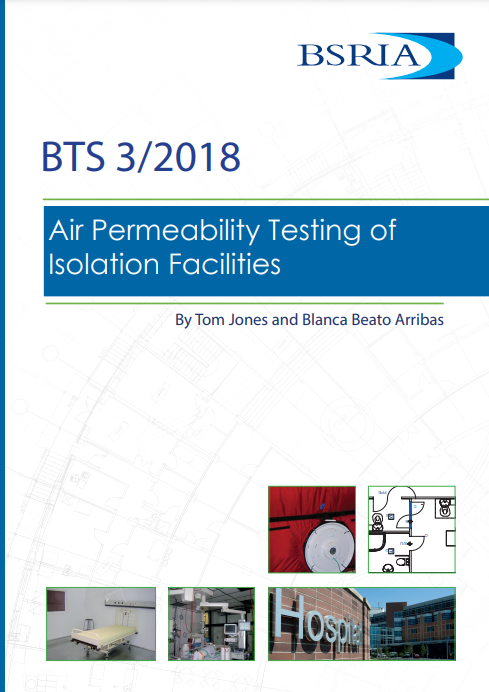Air permeability testing of isolation facilities
Air permeability testing of isolation facilities (BTS 3/2018) was written by Blanca Beato Arribas and Tom Jones and published by BSRIA in 2018.
An isolation suite can be formed of several adjacent rooms, including an entrance lobby, the patient’s room and en-suite facilities and, on some occasions, other rooms such as an exit lobby and an instrument room. Air leakage in isolation suites needs to be minimised to reduce the risk of infection. Air leakage to or from an isolation suite translates into unaccounted-for airborne pathogens travelling from or to other hospital areas.
This standard recommends limits for the overall air leakage of isolation suites in healthcare facilities and also gives recommendations on how to measure air leakage through paths such as doors and door grilles, allowing for comparison against the design specifications.
Air leakage in isolation suites needs to be minimised to reduce the risk of infection. Air leakage to or from an isolation suite translates into unaccounted-for airborne pathogens travelling from or to other hospital areas. The design of the isolation suite should take into account the airflows through the doors, grilles, pressure stabilisers, supply and extract grilles and other components and the air leakage through the envelope. The successful operation of an isolation suite requires the air permeability to be within its required criterion and the airflow through known air leakage paths to be within defined limits.
Contents:
- Introduction
- Specifications
- Test procedure
- Test regime
- Test report
- Appendix A: Calculation of specific leakage rate
- Appendix B: Calculation of leakage through individual elements
- Appendix C: Calculation of leakage through doors
The standard can be downloaded free from https://www.bsria.com/uk/product/BA8E4D/air_permeability_testing_of_isolation_facilities_bts_32018_a15d25e1/
[edit] Related articles on Designing Buildings
- Air change rate.
- Air permeability in isolation rooms.
- Air permeability testing.
- Air permeability.
- BSRIA articles on Designing Buildings Wiki.
- Clean indoor air for healthy living - New air filter standards.
- Design of isolation rooms for infection control.
- Hospital isolation rooms.
- Indoor air quality.
Featured articles and news
RTPI leader to become new CIOB Chief Executive Officer
Dr Victoria Hills MRTPI, FICE to take over after Caroline Gumble’s departure.
Social and affordable housing, a long term plan for delivery
The “Delivering a Decade of Renewal for Social and Affordable Housing” strategy sets out future path.
A change to adoptive architecture
Effects of global weather warming on architectural detailing, material choice and human interaction.
The proposed publicly owned and backed subsidiary of Homes England, to facilitate new homes.
How big is the problem and what can we do to mitigate the effects?
Overheating guidance and tools for building designers
A number of cool guides to help with the heat.
The UK's Modern Industrial Strategy: A 10 year plan
Previous consultation criticism, current key elements and general support with some persisting reservations.
Building Safety Regulator reforms
New roles, new staff and a new fast track service pave the way for a single construction regulator.
Architectural Technologist CPDs and Communications
CIAT CPD… and how you can do it!
Cooling centres and cool spaces
Managing extreme heat in cities by directing the public to places for heat stress relief and water sources.
Winter gardens: A brief history and warm variations
Extending the season with glass in different forms and terms.
Restoring Great Yarmouth's Winter Gardens
Transforming one of the least sustainable constructions imaginable.
Construction Skills Mission Board launch sector drive
Newly formed government and industry collaboration set strategy for recruiting an additional 100,000 construction workers a year.
New Architects Code comes into effect in September 2025
ARB Architects Code of Conduct and Practice available with ongoing consultation regarding guidance.
Welsh Skills Body (Medr) launches ambitious plan
The new skills body brings together funding and regulation of tertiary education and research for the devolved nation.
Paul Gandy FCIOB announced as next CIOB President
Former Tilbury Douglas CEO takes helm.
UK Infrastructure: A 10 Year Strategy. In brief with reactions
With the National Infrastructure and Service Transformation Authority (NISTA).























